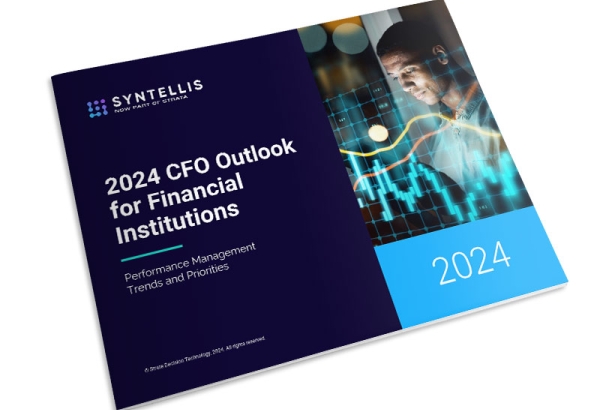2023 was fraught with challenges for the financial services industry, so it’s no surprise that financial institution CFOs have concerns about the year ahead. Following last year’s high-profile bank failures, shifting consumer preferences, and rising competition, finance leaders must consider how to strengthen their institutions for an uncertain future.
In Syntellis’ 2024 CFO Outlook for Financial Institutions, we surveyed finance professionals at banks, credit unions, and other financial institutions across the U.S. Below, we explore some of the key concerns that keep CFOs up at night and how better profitability analytics can equip their institutions to succeed in 2024 and beyond.
Key concerns for CFOs in 2024
Long-running economic uncertainty continues to be a major concern for finance leaders. Asked what they expect will be major drivers of business model changes in 2024, a vast majority (98%) cited the ongoing impacts of interest rate changes. More than two-thirds of respondents (68%) noted customer attrition, as mounting competition and the rise of non-traditional banking services mean that customers have more options than ever. More than a quarter of survey respondents (28%) also cited the challenges of remaining in compliance with increasing regulatory requirements.
Twenty-six percent of survey respondents are concerned about changes in the competitive landscape, with a number of disruptive forces on the horizon. When asked to predict the factor expected to have the greatest impact on the financial services industry, 24% cited artificial intelligence (AI), while 23% said neobanks and other digital-only financial services providers. More than one in five (21%) also expressed concerns about the long-term effects of continued staffing issues and resource constraints. Other factors expected to significantly impact the industry included cybersecurity, cryptocurrency, and blockchain.
A path to profitability
Despite these concerns, financial institution leaders see a clear path to profitability, both expanding on areas of growth from 2023 and capitalizing on emerging profitability drivers.
While leaders foresee slightly less growth in consumer loans and cashless payments — which were common sources of growth in 2023 — they anticipate other areas to become core profitability drivers. Eighty-nine percent of respondents indicated commercial loans as a key area of anticipated growth. Other areas of projected profitability growth include credit cards (88%), small business loans (82%), deposits (80%), and mortgage loans (80%).
While this paints an optimistic picture for financial institutions, it also highlights a core challenge for CFOs: using profitability analytics to inform strategies for success.
Using data to inform strategic decisions
Amid an increasingly diverse set of products and services and other industry challenges, financial institutions have increased efforts to integrate data into strategic decision-making. However, most finance leaders agree their organizations can improve how they leverage data to understand current and future market trends.
While 90% of respondents said their institutions use financial and operational data to inform strategic decision-making, just 8% said that data is central to their strategies and they use it exceptionally well. Most see significant room for growth.
Specifically, many institutions see a growing need for profitability analytics and reporting capabilities. Nearly seven in 10 (69%) finance professionals are actively working to implement or improve profitability analytics at their institutions.
Survey respondents identified several limitations to their ability to analyze profitability: 64% said they had difficulties accessing the right data, 46% cited insufficient tools to calculate and analyze results, and 36% indicated limited organizational knowledge to perform the analysis. Many of these challenges are exacerbated because institutions rely on outdated tools. For instance, 21% of survey respondents use spreadsheets for reporting and profitability analysis.
Modernizing their profitability analytics capabilities can equip leaders to identify which customers, segments, branches, and models drive the greatest value, so they can make strategic decisions to drive business growth.
Investing in technology to improve profitability analytics
To combat challenges accessing reliable data and insufficient tools, financial institutions continue to invest in new technologies. Seventy-five percent of survey respondents said data analytics is one of the top areas where they will focus their technology spend in 2024.
Advanced solutions, such as Syntellis’ AxiomÔ Funds Transfer Pricing and Profitability, provide institutions with visibility into true drivers of cost and profitability. Finance leaders can generate reports to capture profitability for all dimensions, such as branch, department, product, or officer. With this information, they can translate raw data into actionable information and determine the right areas of focus to better position their institutions to navigate current and future industry challenges.
Get deeper insights into financial institution performance management trends and priorities by downloading Syntellis’ 2024 CFO Outlook for Financial Institutions.
More resources for financial institutions

2024 CFO Outlook for Financial Institutions

10 Key Financial Metrics & KPIs for Banks & Credit Unions


